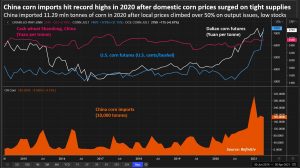The USDA is projecting that the ag trade deficit will shrink in FY2026 even more than previously anticipated. USDA expects the trade deficit to fall from $43.7 billion in FY2025…
Livestock Sector in China Looks to Wheat
Reuters writers Hallie Gu and Gavin Maguire reported on Friday that, “China’s massive livestock sector is set to snap up millions of tonnes of wheat from the country’s winter harvest that began this month, extending a run of crop-switching in animal feed and further cooling demand for corn imports.

“Corn imports surged last year after a decline in stockpiles and production, pushing up prices and reshaping global grain markets as feed producers and pig farmers scoured the world for supplies.
“At the same time, China’s feed sector purchased record volumes of cheaper wheat from the 2020/21 season for use as a substitute for corn, traditionally the main grain in animal rations. ‘Feed demand for wheat is expected to remain very high in the new crop year, as wheat still has obvious advantages against old corn, based on current prices,’ said Li Hongchao, a senior analyst with trade website Myagric.com.”
Chinese corn prices have held a persistent & steep premium over wheat so far this year pic.twitter.com/LGT4kmxCiL
— Gavin Maguire (@GavinJMaguire) May 28, 2021
The Reuters article added that, “While China caps low-tariff corn imports at 7.2 million tonnes a season, buyers imported a record 11.29 million tonnes in calendar 2020, mainly from the United States, as high domestic prices made imports economical even when paying tariffs.
“Feed lots began large-scale wheat substitution from late 2020, effectively easing tight corn supplies and securing domestic feed grain supplies, said Qi Chiming, an analyst with the China National Grain & Oils Information Center (CNGOIC), an official think tank.
“The new wheat crop is expected to further dim demand for imports, with CNGOIC predicting a record harvest in 2021 of 136.4 million tonnes.”
In a closer look at U.S. corn export issues, Reuters columnist Karen Braun pointed out last week that, “Market participants this week became apprehensive regarding China’s massive corn purchasing program out of the United States as cancellation rumors floated around. So far, no additional cancellations have been officially confirmed and the Asian country apparently continues to buy.
“China has been buying unprecedented amounts of U.S. corn for the last year as domestic Chinese prices have risen to record levels amid what are presumed to be dwindling stockpiles. The country has also been rebuilding its hog herd after devastating disease losses that dampened feed demand and slashed pork supplies.
Ms. Braun indicated that,
Earlier this month, USDA projected China would import 26 million tonnes of corn in 2021-22, the same as this year. China’s known U.S. purchases through May 20 cover 41% of next year’s expected needs.
Meanwhile, Bloomberg News reported this week that, “China’s factories, power plants and farms are fielding the worst effects of a surge in commodity costs that’s yet to hurt the wallets of the nation’s citizens.”
“China’s government has intensified its efforts to rein in commodity prices to help these industries weather what it hopes will be a transitory bout of inflation,” the Bloomberg article said.
More narrowly regarding agriculture, the Bloomberg article stated that, “Farmers big and small are also suffering. Investors have punished the shares of the largest hog producers, which are facing a squeeze on margins from higher feed costs — including corn, soybeans and wheat — even as pork prices slump.
“Muyuan Foods Co., China’s biggest pig breeder, said costs are increasing due to higher raw material prices. The timing couldn’t be worse, with futures prices for live pigs in China falling to the lowest since the derivative launched earlier this year.”
The article added that, “And the spike in grain markets is hurting even the producers who should benefit from higher prices.
“Liu Chen, a corn farmer in Heilongjiang province in the northeast, said land rents and labor costs have jumped by about half, while fertilizer prices have risen 20%, amid the run-up in domestic corn prices, which peaked at the start of the year.”
More broadly on variables impacting U.S., China trade, New York Times writer Keith Bradsher reported last week that, “The truce, known as the Phase 1 agreement, could still be supplanted by a new deal. The agreement requires that the two sides conduct a high-level review of it this summer. On Wednesday in Washington, Katherine Tai, the United States trade representative, held an introductory call with a senior Chinese official, Vice Premier Liu He — a signal that Mr. Liu, the same top negotiator who squared off against the Trump administration, will be kept in place by China.
But prospects for a far-reaching new deal this year are slim.
“The Biden administration is drafting a comprehensive strategy toward China, a complex interagency procedure that could last into early next year. It has also shown little appetite for easing up on China’s trade practices, and it has publicly discussed smoothing ties with European and other allies that were ruffled by other disputes during the Trump administration.”
In other news regarding China, Financial Times writer Yuan Yang reported this week that, “China will allow couples to have three children, loosening its historic family planning policies in the face of a looming demographic crisis just weeks after reporting that its population grew at the slowest rate in decades.

“The Chinese Communist party’s politburo, which comprises its 25 most senior officials, concluded that the new ‘three-child policy’ was intended to ‘actively address the ageing population, and maintain China’s natural advantage in human resources,’ according to Xinhua, the state media agency. It was unclear when the policy would take effect.”





